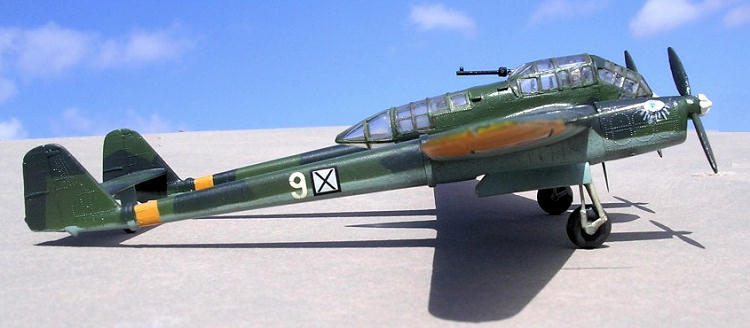
Airfix 1/72 FW-189 'Uhu'
| KIT #: | ? |
| PRICE: | £4 and 6 |
| DECALS: | One option |
| REVIEWER: | Carmel J. Attard |
| NOTES: |

| HISTORY |
The Focke Wulf 189 “Eule” as was known in the popular press was better known as the “Uhu” (owl) to those who flew it because like the owl, its appearance was deceptive. A twin boomed, twin engine with a central fuselage with many windows and a fragile look the airplane was maneuverable and capable of absorbing considerable punishment and still returning to base. It was one of the Luftwaffe’s most successful short-range reconnaissance aircraft in the Second World War.
It was used in a number of fronts particularly that in Russia. Several FW-189 were the victims of Russian ramming attacks and managed to make it back with parts of tail section knocked off the airplane. The Owl was popular with those who flew it and filled an important niche in operations on the eastern front where it saw service almost exclusively while in Luftwaffe service.
The existence of this aircraft was unknown to the allies until 1941 even though several prototypes flew well before the war. It overcame the traditionalists at the RLM with its performance, and began to enter Luftwaffe service in 1941. Its superb handling and agility made it a very difficult and elusive target for the enemy fighters.
Two Argus As410A-1V inverted 12-cylinder engines (465 hp) powered the
FW-189. It carried a crew of 3-4 members, pilot, observer, rear-gunner, and an
observer gunner in the rear ventral position. The FW-189 was heavily armed with
two 7.92 MG17 in inner wings, a twin 7.92mm MG81 for the rear gunner and another
twin 7.92 mm in the rear ventral position. It could also carry four 110lb bombs
under the wings. With great agility the aircraft was able to escape enemy
fighters and on occasions it could reach its
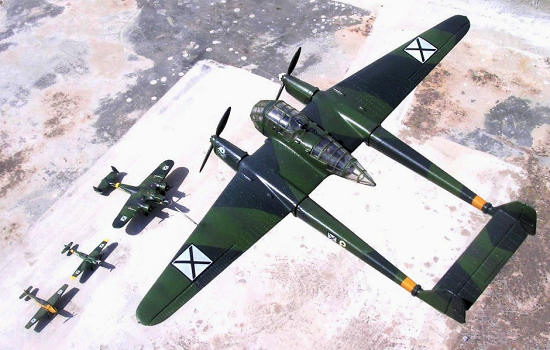 base
with heavy damage.
base
with heavy damage.
Several versions of the FW-189 went into service which included the most common type the FW-189A-1 which was in service with the Luftwaffe’s 2(H) 21; the FW-189A-2 of the Aufklarungsgruppe 3(H) 31 which closely resembled the earlier version. Another version is the FW-189 A3 that featured a loop antenna and a mast antenna over the fuselage. This was a two-seat communication trainer. Finally there was the Fw-189 B1which differed from the previous versions having a solid nose and a solid aft fuselage cone. This version was used as a five-seat dual control trainer. Gradually only the French factories with assembly lines at Bordeaux-Merignac were producing the FW-189 and this discontinued as the allies closed in during 1944. Many different models and a number of developments with more powerful engines were built but only the basic type A-1, A-2, and A-3 appeared in substantial numbers bringing a total of all versions to 846 aircraft.
The Fw-189 in Bulgarian Air Force service.
The major and most powerful Vazdushni Voyski unit in Bulgaria was the Air Eskadra. This was a mixed operational and tactical unit including 2 army, 5 bomber and 6 Fighter Polk. An Aerial Reconnaissance and an Air Training Polk was also created. Polks comprised Orliaks and Yatos and were structurally similar to the German equivalents. The Focke-Wulf Fw-189 A-2 reconnaissance plane started to arrive in Bulgaria in 1943 equipping 334th Yato, 18 of which were delivered. The twin boom Fw-189, was Vazdushni Voiski’s most modern spy-plane at the time. It had excellent visibility all around and its maneuverability made it indispensable to Army commanders who were eager for tactical information. The German aerial camera optics bestowed the Fw-189 reconnaissance plane’s high combat effectiveness. On 1st September 1944 fourteen Fw-189s were among the strength of aircraft that could offer any genuine threat. At the time there was a turn-about in Bulgaria’s orientation and the nation took the form of an imminent participation in the war against Germany and in favor of the Russian forces. This was an entirely different task to those of previous three years.
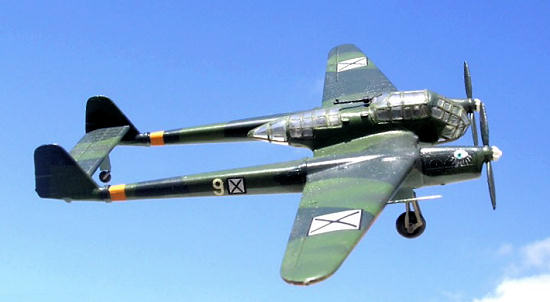 During
the subsequent years against the new enemy, great use was made of the Air
Eskadra and the Reconnaissance Polk. This initially had two orlyaks, 3/1and 4/1.
The first controlled two yata - the 333rd
RY with seven Fw-189A-2, and the 334th
RY with five Fw-189A-2s.This directly involved the effective Fw-189, which
conducted aerial reconnaissance as well as the occasional ground-attack duties.
These were tasks which included the entire strength on hand and which deployed
in support of the 1st and 4th
Armies that advanced towards Skopie and Veles respectively. The advance to Nic
and Belgrade were covered by 17 Air Army, which based at airfields near Vidin
and Sofia. Still there was lack of adequate airfield network in the west of
Bulgaria that could be felt in the effective preparation of the assembled force
for anti-German offensive.
During
the subsequent years against the new enemy, great use was made of the Air
Eskadra and the Reconnaissance Polk. This initially had two orlyaks, 3/1and 4/1.
The first controlled two yata - the 333rd
RY with seven Fw-189A-2, and the 334th
RY with five Fw-189A-2s.This directly involved the effective Fw-189, which
conducted aerial reconnaissance as well as the occasional ground-attack duties.
These were tasks which included the entire strength on hand and which deployed
in support of the 1st and 4th
Armies that advanced towards Skopie and Veles respectively. The advance to Nic
and Belgrade were covered by 17 Air Army, which based at airfields near Vidin
and Sofia. Still there was lack of adequate airfield network in the west of
Bulgaria that could be felt in the effective preparation of the assembled force
for anti-German offensive.
Among the intervening squadrons was the 1st Aerial Reconnaissance Polk commanded by Polkovnik Peter Sapunov with 17 Fw-189As at his disposal, 14 of which were serviceable and belonged to 1/3 Recce. Orliak based at Varb airfield near the Serbian border. These aircraft took part in missions alongside KB-11single engine Recce Aircraft. (The KB-11 has a close resemblance to the Mewa and was much developed and redesign by the KB factory in Bulgaria. It also has a resemblance to the British Lysander). Prior to the Bulgarian land offensive there were 1233 sorties that took place between the 9th of September and the 7th of October, 30% of which were aerial reconnaissance.
On 8th October the FW-189 of the 3/1 Orlyak mounted their first ground attacks on truck convoy located immediately behind the front line. Eight trucks and several combat vehicles were destroyed with machine guns and bombs. On the 17th October, the 333rd RY made its debut in the artillery control role, directing the fire at Strazhin strongpoint. Despite worsening weather and sharp decline in the number of serviceable, the intensity of action was great and the Fw-189 conducted missions to a great degree of success during the Belgrade operation.
| THE KIT |
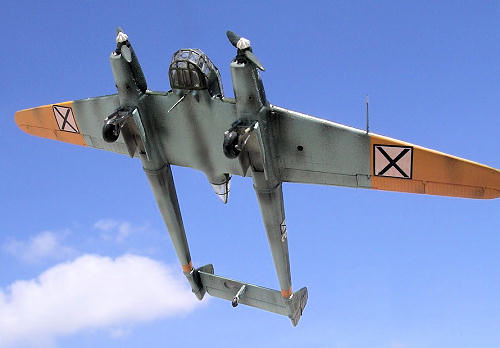 In
the 1/72 scale range, both Airfix and MPM where the first to produce the scale
model of the so called “Uhu”. Airfix was the first to build the model
specifically to fill in another gap with agile combat aircraft and this could
easily be built into another aircraft that has served with the Bulgarian Air
Force in WWII. The kit is moulded in medium grey plastic, having good surface
detail but which looked slightly over scale. This can be smoothened down to
obtain the correct size. The two strengtheners which are at each end of the
booms where they join the main planes to the tail planes can be filed down to
reduce in size and make them less pronounced. A fine streak may also be added
along the top of each boom. This is shown in the box art. This may not be so
conspicuous at 1/72 scale. The prominent spinners with a vaned cap are also
provided although some trimming by thinning down the fine vanes with a smooth
file will improve their appearance. Careful masking of the transparencies when
painting the framework would be beneficial to the very good quality of the
Perspex, being clear and having sharply defined frames with a well fit of the
canopy. Again reference to the box art was a useful guide. The Airfix model with
its 3.25 inches long transparent central nacelle included three accurately
scaled figures representing the pilot, observer, and gunner. A correctly shaped
armor plated seat for the pilot and a control column are basically the interior
detail sand it is hoped that reference to the sketches shown will give ideas for
adding detail and improve the situation. There is also a prone position cushion
type seat for the gunner/bomb-aimer.
In
the 1/72 scale range, both Airfix and MPM where the first to produce the scale
model of the so called “Uhu”. Airfix was the first to build the model
specifically to fill in another gap with agile combat aircraft and this could
easily be built into another aircraft that has served with the Bulgarian Air
Force in WWII. The kit is moulded in medium grey plastic, having good surface
detail but which looked slightly over scale. This can be smoothened down to
obtain the correct size. The two strengtheners which are at each end of the
booms where they join the main planes to the tail planes can be filed down to
reduce in size and make them less pronounced. A fine streak may also be added
along the top of each boom. This is shown in the box art. This may not be so
conspicuous at 1/72 scale. The prominent spinners with a vaned cap are also
provided although some trimming by thinning down the fine vanes with a smooth
file will improve their appearance. Careful masking of the transparencies when
painting the framework would be beneficial to the very good quality of the
Perspex, being clear and having sharply defined frames with a well fit of the
canopy. Again reference to the box art was a useful guide. The Airfix model with
its 3.25 inches long transparent central nacelle included three accurately
scaled figures representing the pilot, observer, and gunner. A correctly shaped
armor plated seat for the pilot and a control column are basically the interior
detail sand it is hoped that reference to the sketches shown will give ideas for
adding detail and improve the situation. There is also a prone position cushion
type seat for the gunner/bomb-aimer.
The kit also includes two 7.9mm MG to cover against air attack from
overhead or behind. The kit has a 10-inch wing span and slightly taper twin
booms and a tail plane assembly representing the robustly built design to
withstand substantial ground and aerial punishment to remain operational. The
Airfix variant is the FW-189 A-2. The 67-piece kit also boasted a detailed
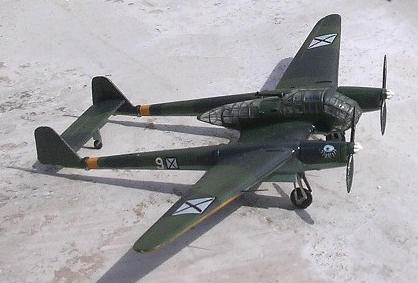 undercarriage
and a pair of accurate Junkers/Hamilton propellers.. The decals are of
reasonably good quality though I did not use them in view of the foreign export
markings that my kit was to carry. In a nutshell this was a neat little kit.
undercarriage
and a pair of accurate Junkers/Hamilton propellers.. The decals are of
reasonably good quality though I did not use them in view of the foreign export
markings that my kit was to carry. In a nutshell this was a neat little kit.
Other models of the Fw-189 were released by MPM who have upgraded and released the kit as a Fw-189 A-1 of 1(H)/Au FkL 32 that was based in Finland in 1943. Italeri has released a neat model of the FW-189 and Condor has also released the FW-189A-1 and being a recent release to a scale of 1/72, it is sharply moulded in light grey plastic with beautifully engraved panel lines. This kit also provides for two camouflaged colour schemes. Finally there is the RS models release, which makes a conversion kit in resin, Fw-189 E, and is intended for use with the Airfix and Bilek models.
| CONSTRUCTION |
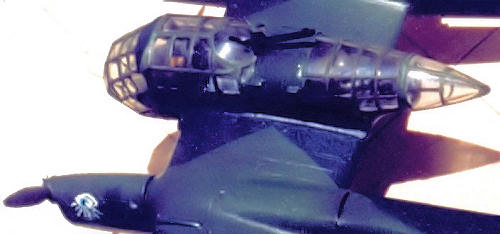 hand.
The fact that the complete airframe can be constructed without the central
nacelle, and with a gap in the wing, means that conversion to the other variants
of the FW189 design, like the trainer version and other various armored assault
versions, is a simple task. The kit was otherwise built following the
instructions. I did not bother about the armament in form of bombs given as it
was to be a fast recce aircraft. In fact I chose to fit the fully-closed
streamlined fairing transparency for the rear gunner position. The collars
around the fuselage were reduced slightly in size to bring them closer to what
they should be on the real aircraft. Looking hindsight I should have sanded down
the riveting which after paintwork still looked on the coarse side in comparison
to the otherwise very smooth skinning on the full size aircraft. All in all the
assembly of the Airfix kit is fairly simple and fit of parts being very good.
Care should be given to align the parts assembly particularly when bringing the
forward main planes and tail planes correctly aligned by checking and sighting
the kit from the front as this is set to dry.
hand.
The fact that the complete airframe can be constructed without the central
nacelle, and with a gap in the wing, means that conversion to the other variants
of the FW189 design, like the trainer version and other various armored assault
versions, is a simple task. The kit was otherwise built following the
instructions. I did not bother about the armament in form of bombs given as it
was to be a fast recce aircraft. In fact I chose to fit the fully-closed
streamlined fairing transparency for the rear gunner position. The collars
around the fuselage were reduced slightly in size to bring them closer to what
they should be on the real aircraft. Looking hindsight I should have sanded down
the riveting which after paintwork still looked on the coarse side in comparison
to the otherwise very smooth skinning on the full size aircraft. All in all the
assembly of the Airfix kit is fairly simple and fit of parts being very good.
Care should be given to align the parts assembly particularly when bringing the
forward main planes and tail planes correctly aligned by checking and sighting
the kit from the front as this is set to dry.
| COLORS & MARKINGS |
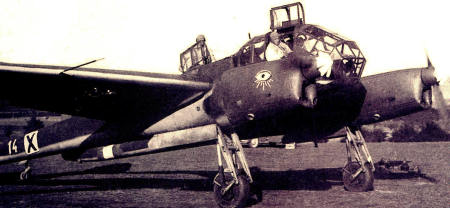 Making
the Bulgarian AF type in service also carried the splinter type camouflage
carried by the Luftwaffe AF on the type of two greens of RLM70 green and
RLM71black green with hellblau RLM65 which is a pale shade of blue undersides.
It also carried yellow GELB RLM04, wing tips and tail booms stripes. The kit
makes up into a most delightful scale model when completed in markings of the
Bulgarian Air Force. Decals for the kit came from Delta Decal sheet No72-002
which is the same decal set used
for the Do-17p, while the “blue eye” motif came from
same source as that mentioned in the past Arado Ar-65 article that can be
located among kit reviews. The kit was given a coat of Johnsons Clear prior to
putting on the decals and in the end finished with a semi matt coat of varnish.
Making
the Bulgarian AF type in service also carried the splinter type camouflage
carried by the Luftwaffe AF on the type of two greens of RLM70 green and
RLM71black green with hellblau RLM65 which is a pale shade of blue undersides.
It also carried yellow GELB RLM04, wing tips and tail booms stripes. The kit
makes up into a most delightful scale model when completed in markings of the
Bulgarian Air Force. Decals for the kit came from Delta Decal sheet No72-002
which is the same decal set used
for the Do-17p, while the “blue eye” motif came from
same source as that mentioned in the past Arado Ar-65 article that can be
located among kit reviews. The kit was given a coat of Johnsons Clear prior to
putting on the decals and in the end finished with a semi matt coat of varnish.
| CONCLUSIONS |
This was yet another addition of combat aircraft that served with the Bulgarian AF during the WWII, a type which fought for and later against the German forces. Perhaps this gives an idea for those who would like to make up German aircraft but in different markings to those of the too common Luftwaffe AF during WWII. The twin boomed fragile looking airplane was maneuverable and capable of absorbing considerable punishment and still return to base and turned out to be one of Luftwaffe’s most successful short-range reconnaissance aircraft of the war.
| REFERENCES |
Ref.”Air Power of the Kingdom of Bulgaria” part IV by Dimitar Nedialkov, Sofia 2001.
If you would like your product reviewed fairly and quickly , please contact me or see other details in the Note to Contributors.